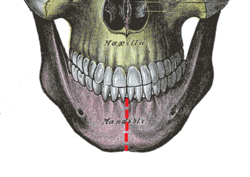
Back ارتفاق ذقني Arabic Símfisi mandibular Catalan Sínfisis mandibular Spanish التصاق چانهای Persian Symphyse de la mandibule French Simfisis Mandibula ID 下顎結合 Japanese Sínfise da mandíbula Portuguese Подбородочный симфиз Russian
| Mandibular symphysis | |
|---|---|
 Anterior view of mandible, showing mandibular symphysis (red broken line) | |
 Medial surface of the left half of the mandible, dis-articulated from the right side at the mandibular symphysis | |
| Details | |
| Identifiers | |
| Latin | symphysis mandibulae |
| TA98 | A02.1.15.004 |
| TA2 | 838 |
| FMA | 75779 |
| Anatomical terms of bone | |
In human anatomy, the facial skeleton of the skull the external surface of the mandible is marked in the median line by a faint ridge, indicating the mandibular symphysis (Latin: symphysis menti) or line of junction where the two lateral halves of the mandible typically fuse in the first year of life (6–9 months after birth).[1] It is not a true symphysis as there is no cartilage between the two sides of the mandible.
This ridge divides below and encloses a triangular eminence, the mental protuberance, the base of which is depressed in the center but raised on either side to form the mental tubercle. The lowest (most inferior) end of the mandibular symphysis — the point of the chin — is called the "menton".[2][3]
It serves as the origin for the geniohyoid and the genioglossus muscles.
- ^ Becker, Marshall Joseph (Apr 1986). "Mandibular symphysis (medial suture) closure in modern Homo sapiens: Preliminary evidence from archaeological populations". American Journal of Physical Anthropology. 69 (4): 499–501. doi:10.1002/ajpa.1330690409. ISSN 0002-9483. Retrieved 2023-12-10.
- ^ "Menton". The Free Dictionary. Retrieved 1 November 2016.
- ^ Phulari, Basavaraj Subhashchandra (2013). An atlas on cephalometric landmarks (1st ed.). New Delhi: Jaypee Brothers Medical Publishers. p. 174. ISBN 9789350903247.
© MMXXIII Rich X Search. We shall prevail. All rights reserved. Rich X Search